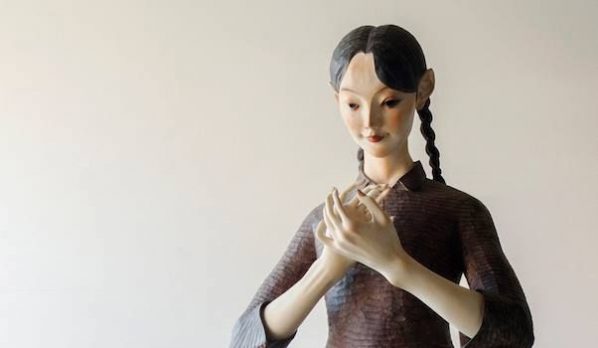
Tina Keng Gallery is pleased to present Axis of Life, the very first solo exhibition of Japanese sculptor Ikki Miyake in Taiwan, with several important series tracing his artistic journey. Born in 1973, Miyake received a Ph.D. degree in sculpture in 2009 from the Tama Art University, Tokyo. One of Japan’s renowned wood sculptors, he is highly sought after on the Asian contemporary art market. Noting the resemblance between the smooth human skin and the surface of the Torreya tree (1) and Kiso-Hinoki cypress, he captures the physical beauty of the human form imbued with a sense of intimacy.
Beginning in 2005, he discovered the physical and spiritual beauty of yoga, which inspired his best-known series "Yoga," an embodiment of his creative concept. The term "yoga" in Sanskrit means "connecting the universe and mankind." Instead of a simple comparison between the human body and wood, the "Yoga" series epitomizes the soul of the natural material. Yoga–Axis (2016), his latest work that debuts in this exhibition, fully manifests his idea of the "connection between the universe and man." Made of the Torreya tree, Yoga–Axis portrays a girl in a yoga pose floating on the pillar that stands for the "axis mundi," referring to the cosmic axis that connects the universe, the sky, and the underworld in ancient mythology, while the earth we inhabit exists in between, bridging heaven and the underworld.
Also on view is Yoga–The Embodiment of Tree, an important piece in the "Yoga" series, which symbolizes the axis-mundi tree connecting heaven and earth. Feet standing firmly on the ground, fingers reaching to the sky, the tree pose in yoga echoes the growth pattern of trees, evoking the connection between heaven and earth, the universe and human world. In two of his recent series “Deity” and “Kodama,” the artist shifts his focus back to corporeality, capturing the essence of what is tangible. Trees act more than just his primary medium, but his source of inspiration. Through these two series Miyake conveys his singular view on Asian culture, wisdom, and philosophy.
Axis of Life mirrors the core concept of Ikki Miyake, where he connects two opposing elements: East and West, ancient and present, mind and body, spirit and form, heaven and earth. Sculptures for him are as much a linkage as an equilibrium between dichotomies, materializing the invisible in a cycle of "being and non-being generate each other." In his contemporary interpretation of sculptural physicality, the artist ingrains into his work through age-old Japanese techniques a yearning for wood and nature, interweaving his practice with tradition and culture as he explores more possibilities in this substantial art form.
(1) The Torreya tree is a precious Japanese fine wood used for the making of Buddha and god statues in Japan since the 8th and 9th centuries.

About the exhibition
Dates: Aug 6, 2016 - Sep 4, 2016
Venue: Tina Keng Gallery
Courtesy of the artist and Tina Keng Gallery.




























